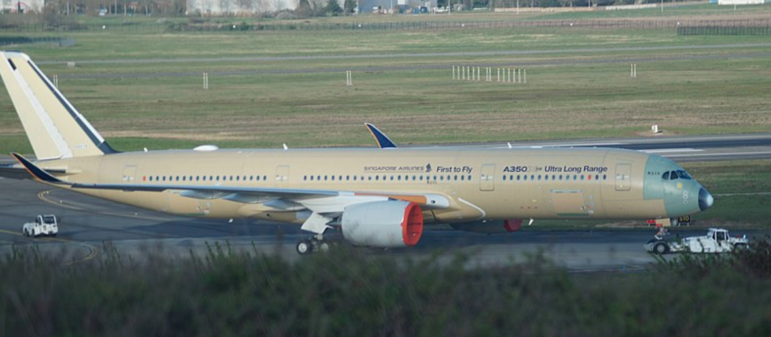I hate to fly, but I have to, sometimes. Sure, I can tolerate a trans-con to California in business or first class. My wife and I once flew to Japan on a surprisingly tolerable 10-hour flight that just felt like a really long day.

But now the big international carriers have newer jets capable of much longer distances non-stop, and the race is on for the bragging rights of “the world’s longest flight.”
In the early days of jet aircraft, an El Al 707 traveling 5,677 miles non-stop from JFK to Tel Aviv in nine and a half hours was quite a feat. But in the mid-1970s when Boeing introduced the 747-SP, a stubby version of the famous jumbo, Pan Am was making it all the way from JFK to Tokyo (6,772 miles) non-stop.
In 2001, Continental and United were flying from New York to Hong Kong (8,065 miles) in 16 hours thanks to new polar routes opened by Russia. But in 2004, Singapore Airlines began non-stop service from Newark, N.J., to its home port (about 10,000 miles) in just over 18 hours.
Mind you, these are regularly flown, passenger-carrying commercial flights. On demonstration flights, the distances and hours aloft are much higher.
When Boeing delivered a brand new, but empty, 777-200ER (Extended Range) from Seattle to Kuala Lumpur, the non-stop flight traveled 12,455 miles. Of course, the plane wasn’t carrying passengers, allowing more weight for fuel.
Starting this fall, a new aircraft will offer even greater range: the Airbus 350-900ULR (ultra-long range). These planes are 25 percent more fuel efficient than the 777s, but don’t offer coach seating, only business and premium economy. More seats would mean more weight, the enemy of being able to add fuel for these mega-distances.
They also have higher ceilings, maintain better humidity and keep cabin pressures higher and noise levels lower, reducing jet lag.

Photo by Edward Louis Richter of Namenlos.net on Wikimedia Commons
Airbus A350-900 XWB Ultra Long Range (in production, without painting, prepared for Singapore Airlines) on the Airport Toulouse-Blagnac (April 3, 2018).
The 19-hour flight for 161 passengers will be expensive: premium economy is $1,649 and business class is double that amount. In its next generation of ULR aircraft, Airbus is considering installing bunk-beds “downstairs” where cargo would normally be stored. There has been no indication how much it will cost.
What’s the limit for non-stop flying? Experts say about 21 hours. That’s enough time to fly between any two spots on the globe.
On the supersonic front, Boom, Aerion and Spike are working on prototypes for smaller jets that could carry up to 55 passengers at speeds ranging from mach 1.5 to 2.2 for distances up to 6,200 miles, almost the distance of New York to Tokyo. By comparison, the Concorde carried 120 passengers at a maximum of 3,900 miles at mach 2.02.
Japan Airlines and Virgin Atlantic have invested $10 million and pre-ordered 20 of Boom’s XB-1 aircraft. The manufacturer estimates a flight between JFK and London would take just over three hours and cost about $2,500 each way.
Longer non-stops seem to be the way of the future.
For you trivia fans: What’s the shortest non-stop commercial jet flight? It’s from Aruba to the Venezuelan city of Punto Fijo, a 50-mile, eight-minute flight that costs $235 one-way.
____________________
Some of Jim Cameron’s other articles on air transportation:
- Hot Weather Can Stifle Airplane Takeoffs: Cameron on Transportation (July 15)
- Air Marshal Service, Created to Prevent Trouble, Is Itself Troubled: Cameron on Transportation (June 17)
- Look! Up in the Air!! And on the Train!!! Another Disruptive Passenger!!!! — Cameron on Transportation (Jan. )
- By 2020 You’ll Need a ‘Verified’ Drivers License If You Want It for ID Before a Flight: Cameron on Transportation (Dec.
- Check Out This Airline If You’re Going to France: Cameron on Transportation (July 28
- Think Air Travel’s Crazy? You Don’t Know the Half of It: Cameron on Transportation (Oct. 7
- Cramming Passengers on Planes Is Not Just Uncomfortable, It’s Also Unsafe (May 19
____________________
Jim Cameron has been a Darien resident for more than 25 years. He is the founder of the Commuter Action Group and also serves on the Darien RTM and as program director for Darien TV79. The opinions expressed in this column, republished with permission of Hearst CT Media, are only his own. You can reach him at CommuterActionGroup@gmail.com.



Pingback: With Worldwide Shortage of Pilots, Expect Cuts in Regular Flight Service: Cameron on Transportation - DarieniteDarienite